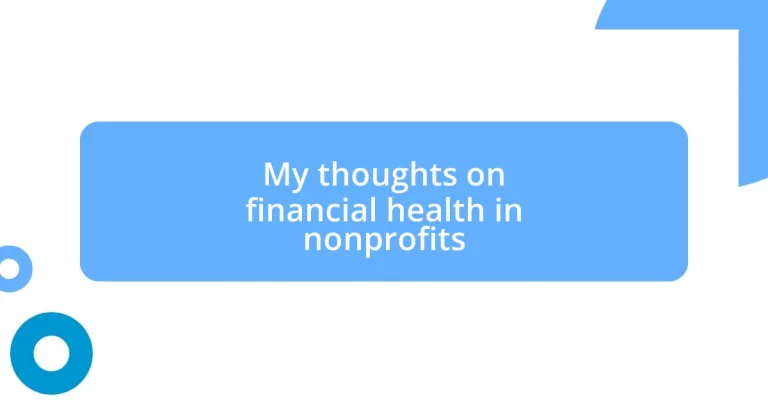Key takeaways:
- Financial health is vital for nonprofits, enabling them to address community needs and foster trust with stakeholders.
- Key financial indicators like cash reserve ratio and program expense ratio help nonprofits evaluate operational resilience and credibility.
- Engaging staff in budgeting processes and setting clear priorities are essential for effective financial management.
- Transparent financial reporting and stakeholder involvement strengthen trust, enhance engagement, and promote a collaborative environment.
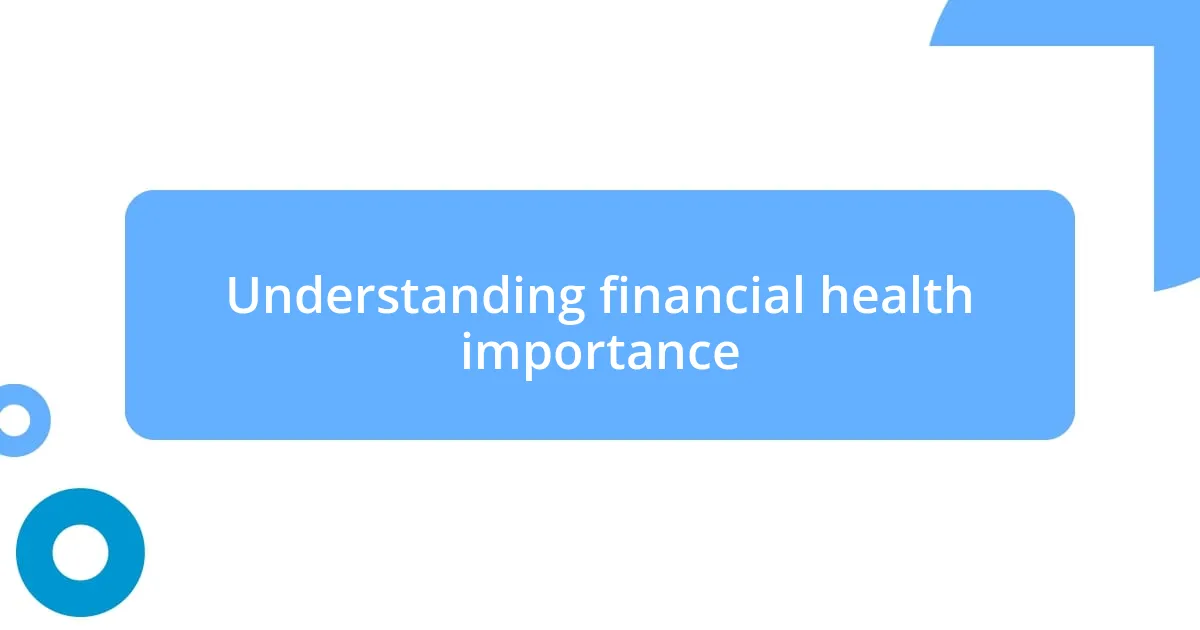
Understanding financial health importance
Financial health is crucial for nonprofits because it directly influences their ability to achieve their missions. I remember a time when I volunteered at a small nonprofit that struggled financially. Watching the organization face constant resource constraints made me realize how financial stability is not just about numbers; it’s about empowering teams to make real impacts in the community.
Consider this: if a nonprofit lacks financial health, how can it effectively respond to the needs of those it serves? From my experience, I’ve seen organizations flourish when they have a solid financial foundation—it allows them to invest in programs, staff, and the communities they aim to uplift. Each dollar effectively spent can mean a world of difference in someone’s life.
Moreover, maintaining financial health fosters transparency and trust with stakeholders. I often reflect on how vital it is for organizations to build relationships with donors; knowing they are supporting a financially sound entity gives them confidence in their contributions. When financial health is prioritized, it creates a cycle of growth that benefits everyone involved.
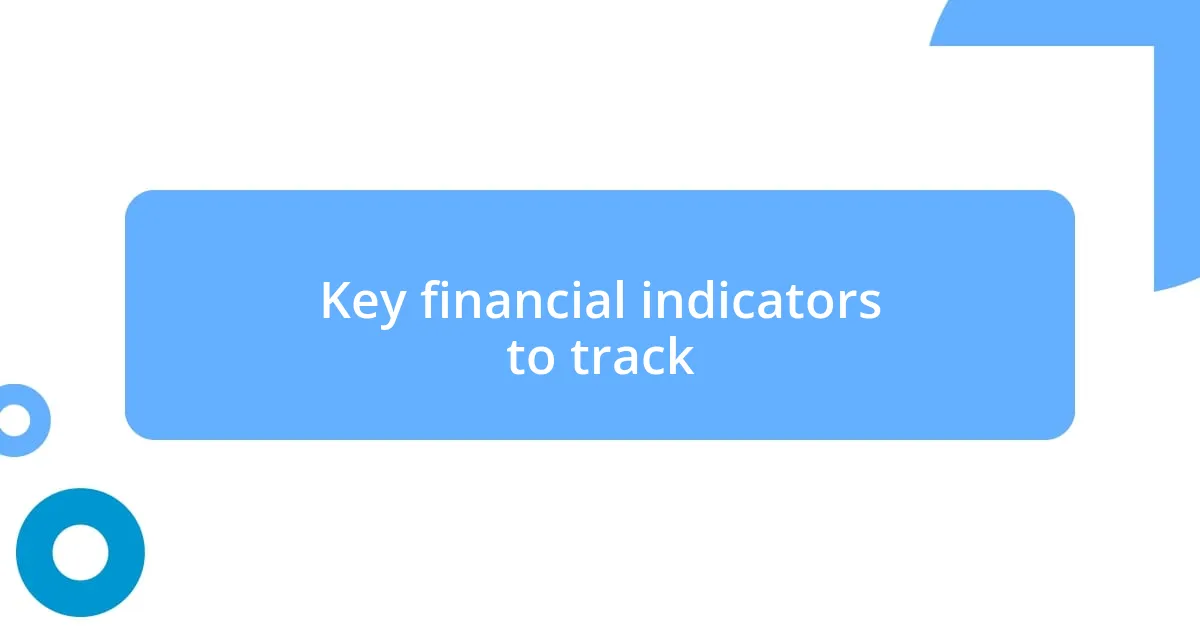
Key financial indicators to track
Tracking key financial indicators is essential for nonprofits to navigate their financial landscape effectively. For instance, I distinctly remember working with an organization that began tracking its cash reserve ratio. This metric helped us understand how many months we could operate without additional income, which proved invaluable when we faced unexpected funding cuts. It’s an eye-opener for nonprofits to realize just how much financial security translates to operational resilience.
Another vital indicator is the ratio of program expenses to total expenses. When I first learned about this metric, I realized that it could make or break a nonprofit’s credibility. A nonprofit that invests a significant portion of its budget in programmatic efforts can demonstrate its commitment to its mission. I’ve found that donors often look at this ratio closely; they want to ensure their contributions are making a meaningful impact, which stirs an emotional connection to the organization.
Lastly, tracking the fundraising efficiency ratio has a profound effect on overall financial health. This metric indicates how much money is raised for every dollar spent on fundraising. I remember a time when our team revisited our fundraising strategies after analyzing this indicator. By streamlining our efforts, we were not only able to raise more funds but also fostered a sense of collective achievement among our team. Financial indicators, when observed closely, empower nonprofits to adjust their strategies, ensuring their missions are fulfilled more effectively.
| Key Financial Indicator | Description |
|---|---|
| Cash Reserve Ratio | Measures how many months a nonprofit can operate without additional income. |
| Program Expense Ratio | Indicates the percentage of total expenses dedicated to program activities. |
| Fundraising Efficiency Ratio | Shows how much money is raised for each dollar spent on fundraising efforts. |
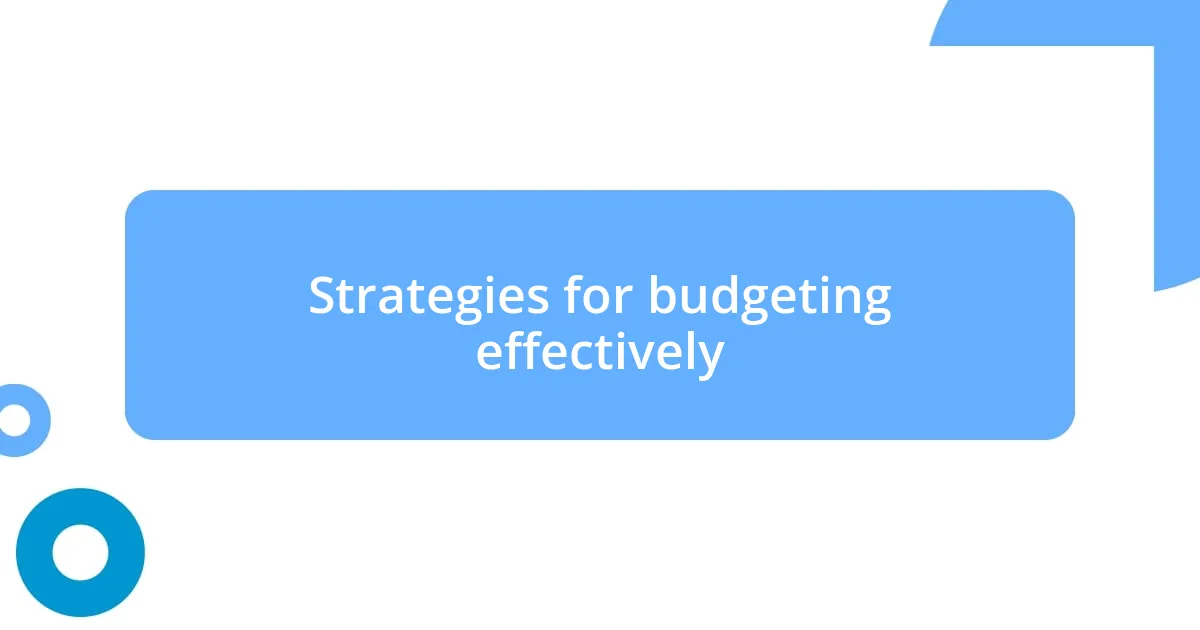
Strategies for budgeting effectively
Developing effective budgeting strategies is a critical component in ensuring nonprofits can fulfill their missions. I recall a project where we utilized a zero-based budgeting approach. This method required us to justify every expense from the ground up rather than simply approving previous budgets. It sparked compelling discussions within our team about priorities, ultimately leading to smarter allocations of resources. This not only tightened our financial processes but fostered a sense of ownership among team members as they became more engaged in the decision-making.
Here are some practical strategies that I’ve found to be quite effective in budgeting:
- Engage your team: Involve staff from different departments in the budgeting process to gain various perspectives and insights.
- Set clear priorities: Align budget allocations with your nonprofit’s mission and goals, ensuring that each dollar spent supports your core objectives.
- Monitor and adjust: Regularly review your budget against actual expenditures, allowing for adjustments as necessary—this agile approach keeps the organization responsive to changes.
I’ve learned that a transparent budgeting process cultivates trust and motivation within the team. When each member understands how funding decisions are made and their implications, it creates a stronger commitment to the nonprofit’s mission. It’s a beautiful synergy when financial discipline meets shared passion.

Managing cash flow in nonprofits
Managing cash flow in nonprofits requires meticulous attention, as it’s the lifeblood that keeps operations running smoothly. I remember a time when a small nonprofit struggled to meet payroll during a lean month. By forecasting our cash flow—and anticipating dips in income—my team developed a plan that involved ramping up grant applications ahead of time. It was a pivotal moment that highlighted how preparation could dramatically ease financial tensions.
Additionally, establishing a cash flow reserve can make all the difference. During my tenure, we decided to set aside a small percentage from each funding influx. This decision provided a cushion during unpredictable funding cycles and, frankly, alleviated a lot of the anxiety that came with uncertainty. Have you ever felt that weight lift when you know you have a backup plan in place? It’s liberating!
Finally, I’ve learned that frequent cash flow monitoring strengthens decision-making. For example, in one organization I worked with, we held monthly cash flow review meetings, allowing us to react quickly to emerging issues. I believe that consistent tracking not only helps in making informed decisions but also empowers the entire team to participate in discussions about financial health, creating a culture of transparency. After all, isn’t a well-informed team the heartbeat of a successful nonprofit?
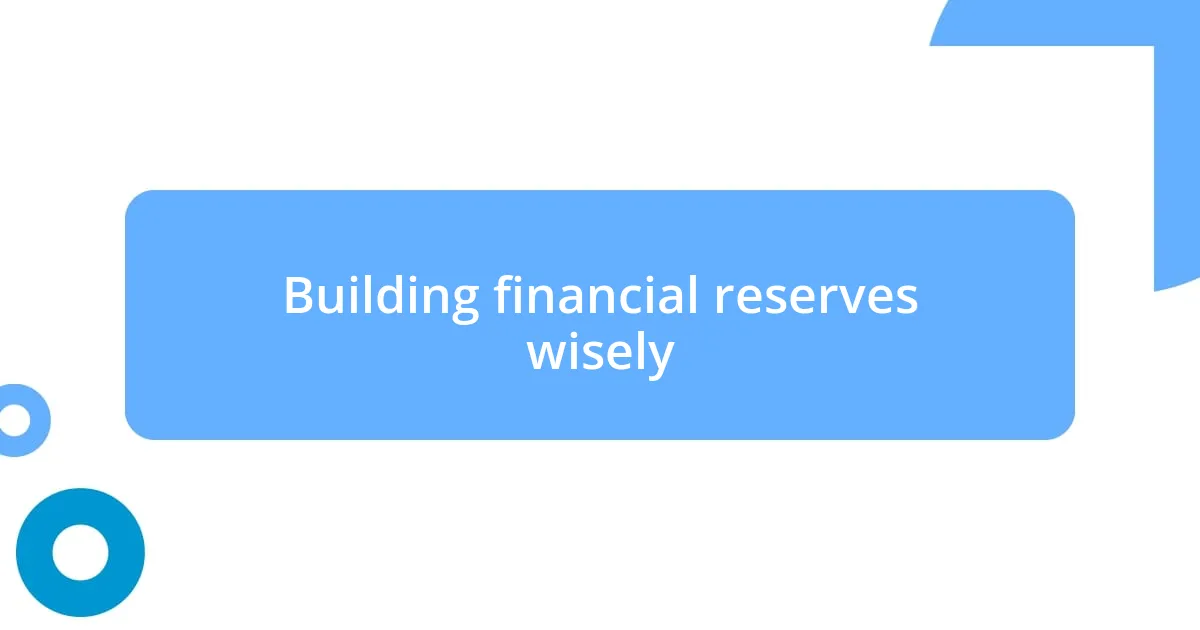
Building financial reserves wisely
Building financial reserves wisely is essential for nonprofits to sustain their operations and weather unforeseen challenges. I remember the tension in our offices whenever unexpected expenses knocked at the door. That’s when we decided to dedicate a portion of our revenue—just 10% at first—to an emergency fund. It felt like an uphill battle to resist spending that seemingly excess money, but as the months went by, seeing that reserve grow was incredibly satisfying. Have you ever felt that comforting reassurance from knowing you’re prepared for what lies ahead?
One approach I found effective was to link our reserve-building strategy to our fundraising efforts. For instance, during one particularly successful fundraising drive, we set a goal to allocate 15% of all funds raised specifically to reserves. This not only highlighted the importance of financial health in our messaging but also engaged our donors more deeply. They appreciated knowing that their contributions would help us not just fulfill our immediate mission but also secure our future. It’s such a powerful feeling when your community rallies around a shared objective, isn’t it?
Finally, I’ve learned the importance of setting clear reserve goals. For my last organization, we implemented a tiered system where we aimed to achieve 3, 6, and eventually 12 months of operational costs in reserves. Each milestone felt like a personal victory, and the journey fostered a culture of financial mindfulness across the board. Because who wouldn’t want to work for an organization that is not just surviving, but thriving, with the ability to invest in future opportunities?
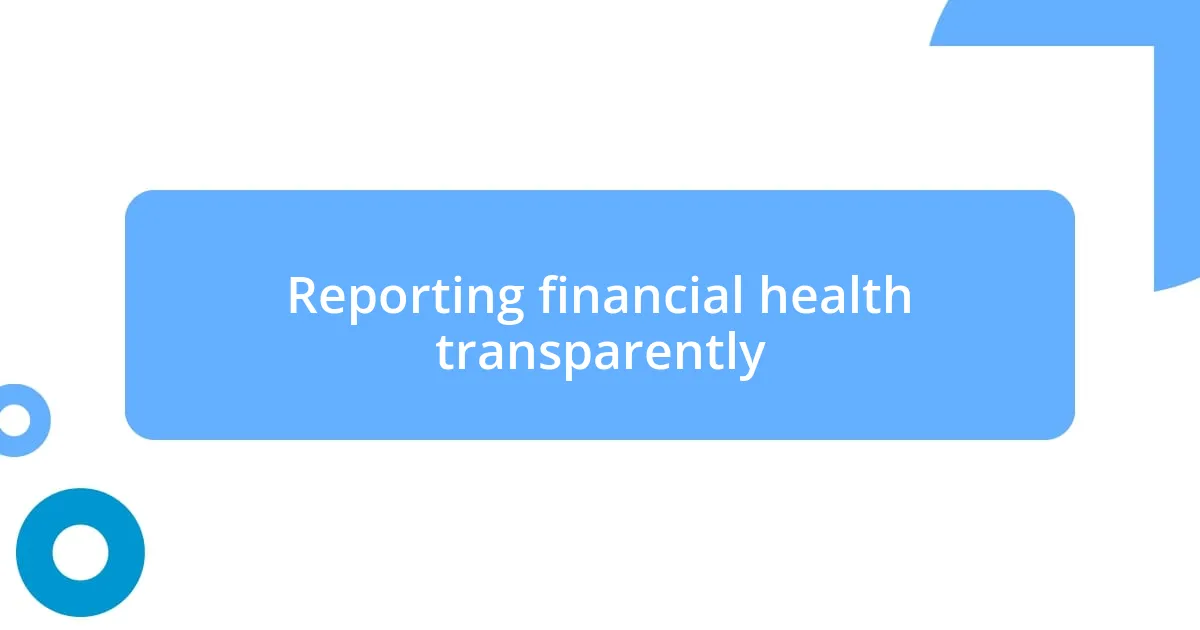
Reporting financial health transparently
When it comes to reporting financial health transparently, I’ve always believed honesty is crucial. I recall a board meeting where we shared our financial statements without sugarcoating any challenges. The openness sparked an unexpected conversation about our financial strategies, leading to valuable input from board members who had diverse expertise. Wouldn’t you agree that a transparent dialogue fosters trust and collaboration within the team?
Moreover, I’ve learned that breaking down financial reports into easily digestible parts can make all the difference. For example, during our quarterly updates, rather than overwhelming everyone with complex spreadsheets, I used simple visuals and infographics. This approach not only drew everyone in but also encouraged more engaging discussions about our financial strategies. Ever experienced that moment when a seemingly complicated topic suddenly becomes clear? It’s empowering for everyone involved.
Additionally, sharing forecasts alongside current financial data can help create a forward-thinking mentality. I remember implementing a practice where we assessed our financial future based on previous trends and current opportunities. This strategy not only kept our stakeholders informed but also inspired them to think proactively about potential funding sources. Isn’t it invigorating to be part of a community that looks towards growth while being rooted in reality?
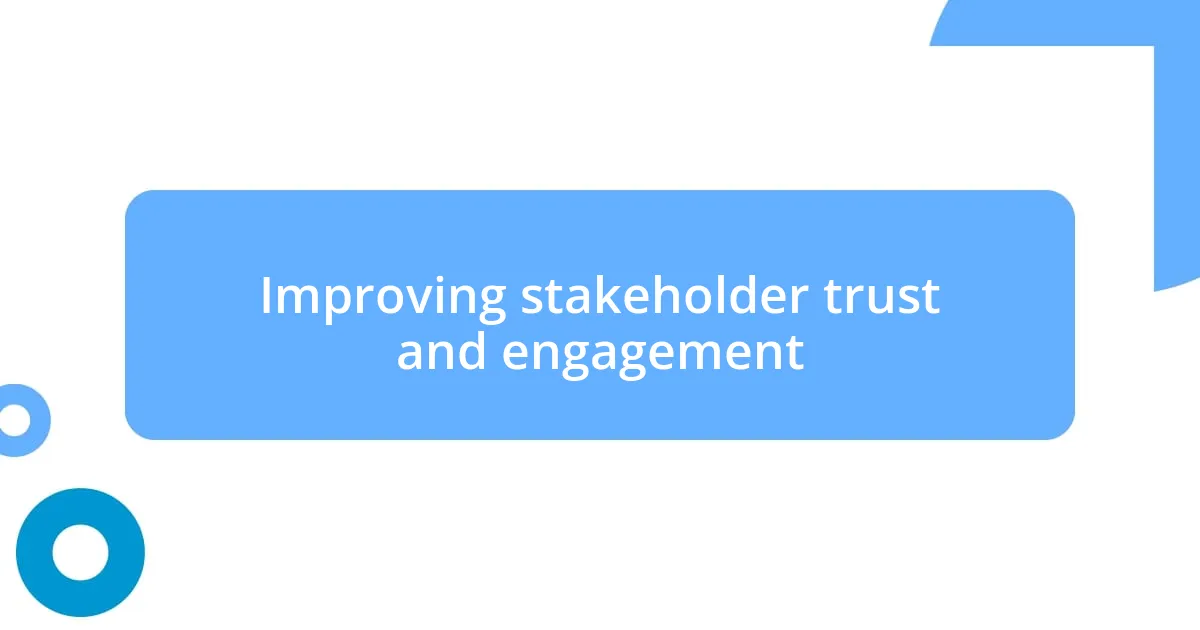
Improving stakeholder trust and engagement
To enhance stakeholder trust and engagement, I’ve found that actively involving stakeholders in decision-making processes is key. During one fundraising campaign, we invited input from our donors on project priorities. This simple yet impactful act not only made them feel valued but also strengthened their connection to our mission. Have you ever felt more invested in something when you had a say in it?
Building relationships through regular communication is another strategy I believe in. I remember hosting quarterly coffee chats, where we discussed updates and challenges openly with stakeholders. These informal gatherings broke down barriers and allowed us to cultivate genuine relationships. It’s remarkable how much trust can flourish in a casual environment, don’t you think?
Furthermore, recognizing and celebrating stakeholders publicly can deepen engagement. At one event, we highlighted our top supporters with heartfelt gratitude, showcasing their contributions. The joy shared that night was palpable; it created a sense of community that went beyond just financial support. How often do we pause to celebrate our partners and their impact? It’s moments like these that truly bind us together.












